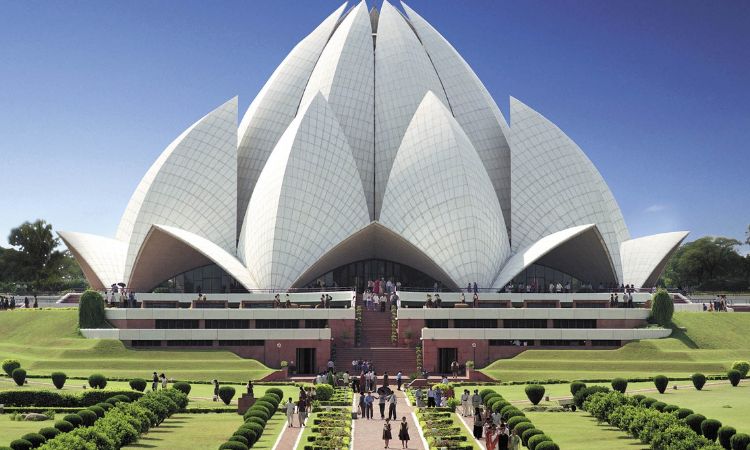
Table of Contents
The Lotus Temple in Delhi is not just an architectural marvel; it’s a beacon of peace, unity, and contemplation. Shaped like a blossoming lotus flower, this Baháʼí House of Worship welcomes people from all faiths, backgrounds, and beliefs, offering a serene space for silent prayer and meditation. Understanding the Lotus Temple timings is crucial for planning your visit to this iconic landmark in India’s capital.
The Architectural Wonder: A Lotus in Marble
Before delving into the Lotus Temple timings, let’s appreciate what makes this structure so unique. Completed in 1986, the Lotus Temple was designed by Iranian-Canadian architect Fariborz Sahba. Its distinctive form, with 27 free-standing marble-clad “petals” arranged in clusters of three to form nine sides, symbolizes purity and peace, mirroring the principles of the Baháʼí Faith. The temple’s nine doors open onto a grand central hall, capable of accommodating up to 2,500 people, emphasizing its message of inclusivity and unity. Surrounding the temple are lush green gardens and nine reflecting pools, enhancing its aesthetic appeal and creating a truly tranquil environment.
Understanding Lotus Temple Timings: Plan Your Visit
The Lotus Temple timings vary slightly depending on the season, primarily to account for the changing daylight hours in Delhi. It’s important to note that the temple is closed on Mondays for maintenance and upkeep.
Here’s a breakdown of the general Lotus Temple timings:
Summer Timings (April to September):
Open: Tuesday to Sunday
Hours: 9:00 AM to 7:00 PM
Winter Timings (October to March):
Open: Tuesday to Sunday
Hours: 9:00 AM to 5:30 PM
It’s always a good idea to check the official Lotus Temple website (
Best Times to Visit
To make the most of your experience at the Lotus Temple, consider these tips regarding visiting times:
Early Mornings: Visiting soon after the temple opens in the morning is often recommended. The crowds are generally smaller, allowing for a more peaceful and reflective experience within the prayer hall and the surrounding gardens. The soft morning light also offers excellent opportunities for photography of the temple’s exterior.
Late Afternoons/Dusk: The temple is particularly enchanting as the sun begins to set. The marble petals glow in the fading light, and the reflecting pools create stunning visual effects. If you’re lucky, you might witness the temple floodlit after dusk, which is a truly spectacular sight. While this time can be busier, the ambiance is unparalleled.
Weekdays vs. Weekends: As with most popular attractions, weekdays tend to be less crowded than weekends and public holidays. If you prefer a quieter visit, aim for a weekday if your schedule permits.
Entry and Facilities
One of the most welcoming aspects of the Lotus Temple is that entry is absolutely free for all visitors. This aligns with the Baháʼí Faith’s principle of universal access and inclusivity. While there’s no entry fee, donations are welcome and contribute to the temple’s maintenance and activities.
Here are a few other important points to keep in mind for your visit:
Photography: Photography is generally permitted outside the temple in the gardens and surrounding areas. However, photography is strictly prohibited inside the main prayer hall to maintain an atmosphere of reverence and quiet contemplation. Visitors are usually requested to deposit their cameras and electronic devices at the entrance.
Dress Code: While there isn’t a strict dress code enforced to the extent of some religious sites, it’s advisable to dress modestly out of respect for the sacred space. Clothing that covers your shoulders and knees is generally recommended.
Silence: The main prayer hall is a place for silent prayer and meditation. Visitors are requested to maintain silence inside the hall to respect the peaceful environment.
Prayer Services: The Baháʼí House of Worship holds devotional services consisting of prayers and readings from various Holy Scriptures. These services are typically 10-15 minutes long and occur at specific times (e.g., 10 am, 12 pm, 3 pm, 5 pm). During these services, the exit door of the prayer hall may remain closed to maintain reverence.
Information Centre: The temple complex also features an Information Centre, where visitors can learn more about the Baháʼí Faith, its principles, and the history and significance of the Lotus Temple through photo panels, written text, and films.
Accessibility: The Lotus Temple is designed to be accessible. Wheelchairs are often available at the main gate on a first-come, first-served basis.
How to Reach the Lotus Temple?
The Lotus Temple is conveniently located in Bahapur, Kalkaji, South Delhi, making it easily accessible via various modes of transportation:
Metro: The most convenient way to reach the Lotus Temple is by metro. The nearest metro station is Kalkaji Mandir Metro Station, which is serviced by both the Violet Line and the Magenta Line. From there, the temple is just a short 5-minute walk.
Bus: Delhi’s extensive bus network also serves the area. You can check for routes that stop near the Lotus Temple.
Taxis/Ride-sharing: Taxis and ride-sharing services are readily available throughout Delhi and can take you directly to the temple complex.
Conclusion
The Lotus Temple is more than just a tourist attraction; it’s a profound symbol of unity and peace that resonates with visitors from all walks of life. By being mindful of the Lotus Temple timings and preparing for your visit, you can ensure a serene and enriching experience at this architectural marvel and spiritual haven in the heart of Delhi. Whether you seek quiet contemplation, architectural inspiration, or simply a moment of tranquility amidst the bustling city, the Lotus Temple offers a unique and memorable retreat.
Frequently Asked Questions (FAQS)
1. What are the general Lotus Temple timings?
Ans. The Lotus Temple is generally open from 9:00 AM to 7:00 PM during summer (April to September) and 9:00 AM to 5:30 PM during winter (October to March).
2. Is the Lotus Temple open every day of the week?
Ans. No, the Lotus Temple is closed on Mondays for maintenance. It is open to visitors from Tuesday to Sunday.
3. Is there an entry fee to visit the Lotus Temple?
Ans. No, entry to the Lotus Temple is absolutely free for all visitors, regardless of their faith or background.
4. Can I take photos inside the Lotus Temple?
Ans. Photography is strictly prohibited inside the main prayer hall of the Lotus Temple to maintain an atmosphere of peace and reverence. However, you are welcome to take photos in the gardens and outside areas of the temple complex.
5. What is the best time to visit the Lotus Temple to avoid crowds?
Ans. Visiting early in the morning, right after the temple opens, or on a weekday generally ensures a quieter and more peaceful experience with fewer crowds.
6. Is there a dress code for visiting the Lotus Temple?
Ans. While there isn’t a strict formal dress code, it is advisable to dress modestly out of respect for the sacred space. Covering your shoulders and knees is generally recommended.
7. How long does a typical visit to the Lotus Temple take?
Ans. A typical visit to the Lotus Temple, including exploring the gardens, viewing the exterior, and spending some time in the prayer hall, usually takes between 1 to 2 hours.
8. Are there prayer services held at the Lotus Temple?
Ans. Yes, the Baháʼí House of Worship holds devotional services consisting of prayers and readings from various Holy Scriptures. These are typically short (10-15 minutes) and occur at specific times throughout the day (e.g., 10 am, 12 pm, 3 pm, 5 pm).
9. How can I reach the Lotus Temple using public transport?
Ans. The most convenient way to reach the Lotus Temple is by Delhi Metro. The nearest metro station is Kalkaji Mandir Metro Station (on both the Violet and Magenta Lines), which is a short walk from the temple. Buses, taxis, and ride-sharing services are also available.
10. What is the significance of the Lotus Temple’s design?
Ans. The Lotus Temple is designed in the shape of a blossoming lotus flower, symbolizing purity, peace, and unity – core principles of the Baháʼí Faith. Its nine sides and nine doors emphasize the faith’s message of inclusivity and open welcome to people of all religions.


